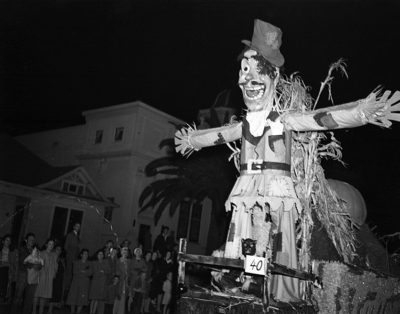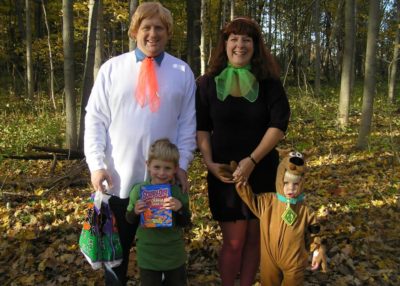Of all of the American holiday traditions, few are as intertwined with our memories of childhood as much as choosing and wearing a Halloween costume. While many of us recall the plastic and vinyl creations of Ben Cooper, Inc., the practice of donning spooky getups goes back literally hundreds of years. Just how did costumes make the jump from 16th century Scotland to modern America, and what kind of impact has it made on our popular culture? Grab your flashlight, make sure you wear something reflective, and we’ll find out.
The beginnings of Halloween can be traced all the way back to the Gaelic harvest festival Samhain, which began on October 31st. Samhain was celebrated in Scotland, Ireland, and on the Isle of Mann, while the similar Calan Gaeaf took place in Wales and areas of Brittany and Cornwall. Irish myths suggest that Samhain was a time when the borders between our world and the Otherworld (the home of the dead and other spirits) were at their thinnest, or even wide open. By the 1500s, it’s certain that two traditions were in effect: guising and mumming. Mumming refers to Mummers’ plays, which have characters in costumes and masks; the plays generally involve some kind of battle and the resurrection of a deceased character. Guising was a very early form of trick-or-treating, with costumed children going door-to-door for treats like coins or food. Some sources tie the practice of guising to the notion that dressing like spirits or monsters would protect you from them if they crossed from Otherworld; it was thought that they would leave humans alone if they couldn’t distinguish them from other creatures.

While it’s not certain when the practice made the jump to America, its growth may have been hastened by waves of immigrants in the 1800s. By that time, the Catholic Church in Europe had worked to push Samhain aside, but All Hallows’ Eve, aka Halloween, stuck. In the late 1800s, it began to take a turn toward being a more family-oriented holiday. There are records of Halloween parades in Scranton, Pennsylvania in 1894 and Topeka, Kansas in 1895; also in 1895, the Indianapolis Journal reported on the “annual” Halloween parade in Anderson, Indiana. In every case, costumes were mentioned in the descriptions of the events; these were generally homemade takes on ghosts, witches, and assorted ghouls. By 1911, Ontario, Canada newspapers were covering children going “guising” in their neighborhoods. In 1927, a new term for guising appeared in print for the first time in Alberta, Canada: trick-or-treat.
With community Halloween parades and trick-or-treating codified in America, it wouldn’t be long before businesses started to take advantage of interest in the celebration. Halloween cards started to appear during World War I. Ruth Edna Kelley’s seminal The Book of Hallowe’en pulled together a lot of the history and folklore in one place for the first time in 1919, while the following year would see the Beistle Company begin to introduce a range of Halloween decorations, like paper skeletons. In this same period, new costume archetypes began to appear; kids were starting to dress as soldiers or police or fire fighters. A.S. Fishbach, Inc. company upped the game in the 1930s by purchasing a license from Walt Disney to produce costumes based on characters like Mickey Mouse and Donald Duck.

In the 1930s, several factors brought significant changes to Halloween and Halloween costumes in America. While the Great Depression was still ongoing, U.S. audiences nevertheless flocked to movie theaters, and few draws were bigger than the monster pictures produced by Universal. Beginning in 1931 with Frankenstein and Dracula, the company would churn out years of horror hits that inspired all manner of costumes. Theatrical costume designer Ben Cooper saw the opportunity for success; he set up Ben Cooper, Inc., in 1937 and took over A.S. Fishbach, Inc. and their licenses. Cooper famously created inexpensive vinyl costumes paired with plastic masks; Cooper costumes were sold all over the country in department stores and five-and-dimes. Traditional costumes for devils and witches and the like would never go away, but pop culture would become a major driver of what Americans wore for Halloween. Cooper tried to stay at the forefront of licensing; when properties like Superman and Davy Crockett broke out on TV in the 1950s, Cooper was there with a costume.
Over time, costumes for adults became just as important to businesses as costumes for kids. While kids were wearing costumes to school for Halloween events and parades, adults congregated more and more for their own parties. Television shows more frequently featured Halloween episodes with elaborate parties or costumes. At the same time, Cooper showed foresight by jumping onto trends promptly; the company licensed Spider-Man early in the character’s existence in 1963, and acquired the rights to Batman costumes two years before the hugely successful TV show hit the air in 1966. Other costume companies like Collegeville and Halco did extremely well as the growing popularity of costumes and costumed events in the 1960s and 1970s allowed room for multiple companies to profit.
In the ’70s, other events fueled costume demand throughout the year. While fantasy conventions had been popular since the 1930s, the first San Diego Comic-Con International ran in 1970, followed two years later by the first significant Star Trek convention, Star Trek Lives! The arrival of Star Wars in 1977 brought a whole new energy to Halloween costumes, with a cast of heroes, aliens, droids, and Darth Vader inspiring looks for years. Over time, dressing up for school fell out of favor as public spaces endeavored to be more sensitive to students who didn’t celebrate the holiday for religious reasons, but there have been community and neighborhood events to fill that gap.

In the past few decades, Halloween has gone on to become staggeringly profitable in the United States. The National Retail Federation has been tracking Halloween spending for years, and their findings have been anything but scary for the companies that support the holiday. In 2005, the group found that more than 50 percent of consumers were going to buy a costume, with total holiday spending exceeding $3 billion; by the next year, that number had jumped to just under $5 billion. The NRF found that 2017 spending was more than $9 billion, with $3.4 billion of that accounted for by costumes alone. And while the holiday took a hit from COVID-19 in 2020, Americans are expected to spend a record $10.14 billion in 2021.
So, as Jack Skellington once asked, “What does it mean?” One can say with certainty: Americans love dressing up for Halloween. Moreover, they love decorating for it, too. The original intent of dressing up for Samhain may have been to hide from spirits and monsters, but the modern iteration offers people a chance to be someone — or something — else for just one day. And since we occasionally live in scary times, that old practice of tricking monsters has really become a way to treat ourselves.
Feature Image: Picryl
Become a Saturday Evening Post member and enjoy unlimited access. Subscribe now




Comments
Halloween when I was 12 years old was very memorable. For years I heard about how my maternal grandmother had made a horse costume for my mother. It took a lot of begging but for once I got what I wanted. My younger brother got to be the rear end. It wasn’t quite the fantasy I’d hoped for since it was very hard to see since I had eyeglasses under the costume. But it was memorable nonetheless.
Halloween 1963: I wore a JFK mask, sport coat, & tie & did what I thought was my JFK impression. I was 12.
Less than a month later, the President was dead, & I’ve been literally haunted since then about my choice of costume. I decided the next year I was too old to trick’r treat.
Since there were no comments on your cover collection, I’ll just mention that I loved John Falter’s “Burbs” cover. Especially the square jack o lantern hanging from the carport! We live in a neighborhood with a few old houses like that; may even have a couple of trick-or-treaters this year! Hope so!